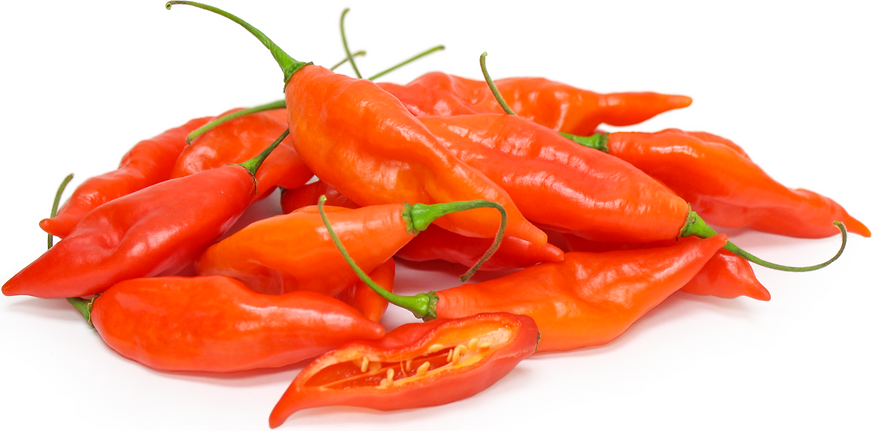


Hot Paper Lantern Chile Peppers
Estimated Inventory, lb : 0
Description/Taste
Hot Paper Lantern chile peppers widely vary in appearance depending on growing conditions, but the peppers are generally elongated, curved to straight pods, averaging 7 to 10 centimeters in length, and have a conical to pendant shape that tapers to a slender, distinct point on the non-stem end. The skin is waxy, firm, and smooth to slightly wrinkled with shallow creases, ripening from green, orange, to orange-red when mature. Underneath the surface, the flesh is thin and crisp, encasing a narrow, central cavity filled with small round and flat, cream-colored seeds. Hot Paper Lantern chile peppers have a subtly sweet, fruity flavor followed by an intense, very hot level of spice that is centered in the back of the throat.
Seasons/Availability
Hot Paper Lantern chile peppers are available in the mid to late summer.
Current Facts
Hot Paper Lantern chile peppers, botanically classified as Capsicum chinense, are a habanero type pepper that belongs to the Solanaceae or nightshade family. The peppers range 150,000-450,000 SHU on the Scoville scale, measuring slightly hotter than common habanero varieties, and the pods are also slightly larger and more exaggerated in length. Despite their differences in heat and physical appearance, Hot Paper Lantern chile peppers can be used as a substitute for common habanero varieties in culinary applications and will add intense spice with fruity, sweet flavors. The peppers can be harvested at any stage of maturity but are most commonly utilized in cooking when red and fully ripe.
Nutritional Value
Hot Paper Lantern chile peppers contain vitamins A and C, iron, folate, magnesium, fiber, and riboflavin. The peppers also contain capsaicin, which is a chemical compound that triggers the brain to feel spice or heat and has been shown to have anti-inflammatory properties.
Applications
Hot Paper Lantern chile peppers are best suited for both raw and cooked applications such as roasting, grilling, sautéing, frying, and simmering. The peppers can be chopped in salsa, blended into hot sauces, cooked into pepper jelly, or used to flavor marinades for grilled meats. Hot Paper Lantern chile peppers can also be incorporated whole into soups, stews, or curries to impart a spicy, fruity flavor. It is important to note that the whole pods are often removed after cooking to reduce the levels of spice. In addition to flavoring, the peppers can be stuffed with cheeses, battered, and fried, roasted to enhance their fruity flavor, or pickled for extended use as a tangy, fruity, and sweet condiment that can be layered in sandwiches and on burgers. Hot Paper Lantern chile peppers can also be dried and ground into a powdered seasoning. When handling the peppers, gloves and goggles should be worn as the capsaicin can profoundly irritate the skin and eyes. Hot Paper Lantern peppers pair well with citrus juice such as lime, orange, and yuzu, tropical fruits such as pineapple and mango, tomatoes, avocados, allspice, shellfish, pulled pork, vinegar-based sauces, creamy cheeses, tequila, and mescal. The fresh peppers will keep 1-2 weeks when loosely stored whole and unwashed in a plastic bag in the refrigerator.
Ethnic/Cultural Info
Hot Paper Lantern chile peppers are an early-season habanero type that was developed to thrive in cooler climates. Marketed as “a habanero for the north” by many seed catalogs, Hot Paper Lantern chile peppers are a successful home garden variety, especially in difficult growing regions, and are compact plants that can bear high yields in small spaces and containers. Home gardeners and self-proclaimed “chiliheads” also value this variety for its large pod size, fruity flavor, and intense heat. The peppers are commonly cooked into homemade hot sauces and are dried and ground into a powder for extended use as a spice.
Geography/History
Hot Paper Lantern chile peppers are descendants of peppers native to the rainforests of South America that have been grown for hundreds of years. These ancient peppers were then transported into Central America, Mexico, and the Caribbean via immigrating tribes and peoples, and as pepper cultivation increased, many new varieties were developed through selective breeding of the native peppers. Today Hot Paper Lantern chile peppers are not commercially cultivated and are found through online seed catalogs for home garden use in Australia, North, Central, and South America, and Europe.
Recipe Ideas
Recipes that include Hot Paper Lantern Chile Peppers. One
| Daily Improvisations |
|
Hot Pepper Lantern Pickled Peppers |




